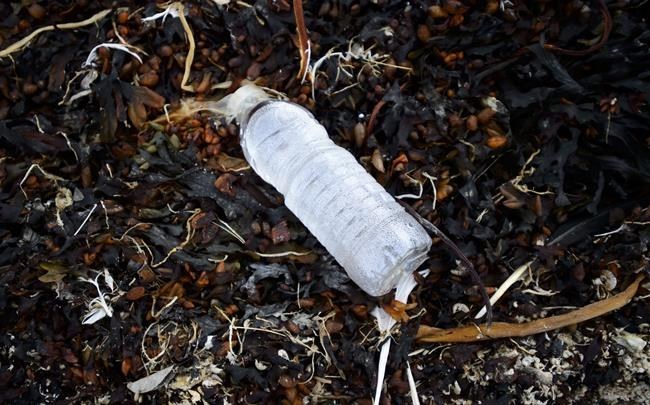OTTAWA — New Canadian data suggest that over a nine-year period between 2012 and 2020, the equivalent of more than 15 billion plastic bottles and as many as 14 billion plastic grocery bags became litter in Canada's environment.
The numbers are based on a new data set Statistics Canada compiled to support the federal government's "zero-plastic waste agenda."
The report was published in March, ahead of the global plastic treaty negotiations being held in Ottawa this week. The United Nations environment office is overseeing the talks, which aim to find international consensus on how to eliminate plastic waste by 2040.
The report shows that Canada produced or imported 7.1 million tonnes of plastic in 2020, up 28 per cent from 2012.
Packaging accounted for almost one-third of the plastic used, and construction plastics accounted for one-fifth. One-seventh of it went to make vehicles, and one-tenth to make electronics and electrical parts.
That same year, almost five million tonnes of plastic was discarded, most of it intended for landfills. About one-sixth was diverted to be recycled, but the data does not indicate how much of that was actually recycled and how much ended up in a landfill after all.
A 2019 study done for the federal government reported that less than one-tenth of plastic waste in Canada is recycled. The city of Toronto says about 13 per cent of what residents put in their blue bins is ultimately thrown out because its facilities can't process some products.
The report also estimates that between 2012 and 2020 nearly 350,000 tonnes of plastic "leaked" into the environment. Almost half of that, 155,000 tonnes, was plastic packaging, including 31,000 tonnes of plastic bottles and 73,000 tonnes of plastic film that is used to make grocery bags and food wraps.
By weight, that converts to approximately 15.5 billion plastic disposable water bottles, and as many as 14.4 million single-use plastic grocery bags.
Another 45,000 tonnes came from other rigid plastic containers, like yogurt cups, clamshells and laundry soap bottles.
Alice Zhu, a PhD candidate in ecology at the University of Toronto and researcher at the school's "Trash Team" research lab, said she did her own study recently that found 4,000 tonnes of plastic is leaking into the environment from Toronto alone each year.
The sources are varied, she said, but include littering, trash blowing out of curbside collection bins or falling off the back of garbage trucks, and microplastics that come loose when plastic fibres are washed down the drain of a washing machine, or rubber dust wears off tires as they rub against the road.
"If you have plastic leaking into the environment, that has a multitude of effects including but not limited to the greenhouse gas emissions that come from the plastic as it degrades, but also it can lead to a variety of negative impacts on living organisms," said Zhu.
Plastic can strangle wildlife, tear open their intestinal tracts or build up in their stomachs over time causing starvation and death.
Microplastics are also being found more often in food and drinking water, and evidence is growing about the negative health impacts on humans including hormone disruptions and cancers.
Plastics are made from thousands of different chemicals, mostly derived from fossil fuels, including ethylene, styrene, propylene and vinyl chloride.
The discussion at the plastic treaty negotiations are aimed at stopping all plastic from ending up as garbage by 2040, so that no plastics end up in landfills or leaked into the environment.
Zhu said the solutions lie in all stages of the plastic life cycle. Reducing how much virgin plastic is made is critical, she said, which will mean mandating that more recycled plastic be used, and making it more expensive to use virgin plastic than recycled plastic.
Currently new plastic, which is cheaper and easier to make, dominates the market.
The Statistics Canada data shows Canada only produced or imported 362,000 tonnes of recycled plastic pellets in 2020, out of more than 7.1 million tonnes of plastics total.
Zhu said municipalities also must harmonize their recycling programs, because it is extremely confusing for consumers when the products that can be recycled varies greatly from one jurisdiction to the next.
Toronto, for example, doesn't allow for black plastic like garbage bags and plant trays to be recycled. Peel Region right next door does.
Ottawa refuses to take any kind of plastic film, including grocery bags, while Toronto accepts grocery bags and resealable sandwich bags, but not cling wrap, bubble wrap or the bags inside cereal boxes.
This report by The Canadian Press was first published April 25, 2024.
Mia Rabson, The Canadian Press




